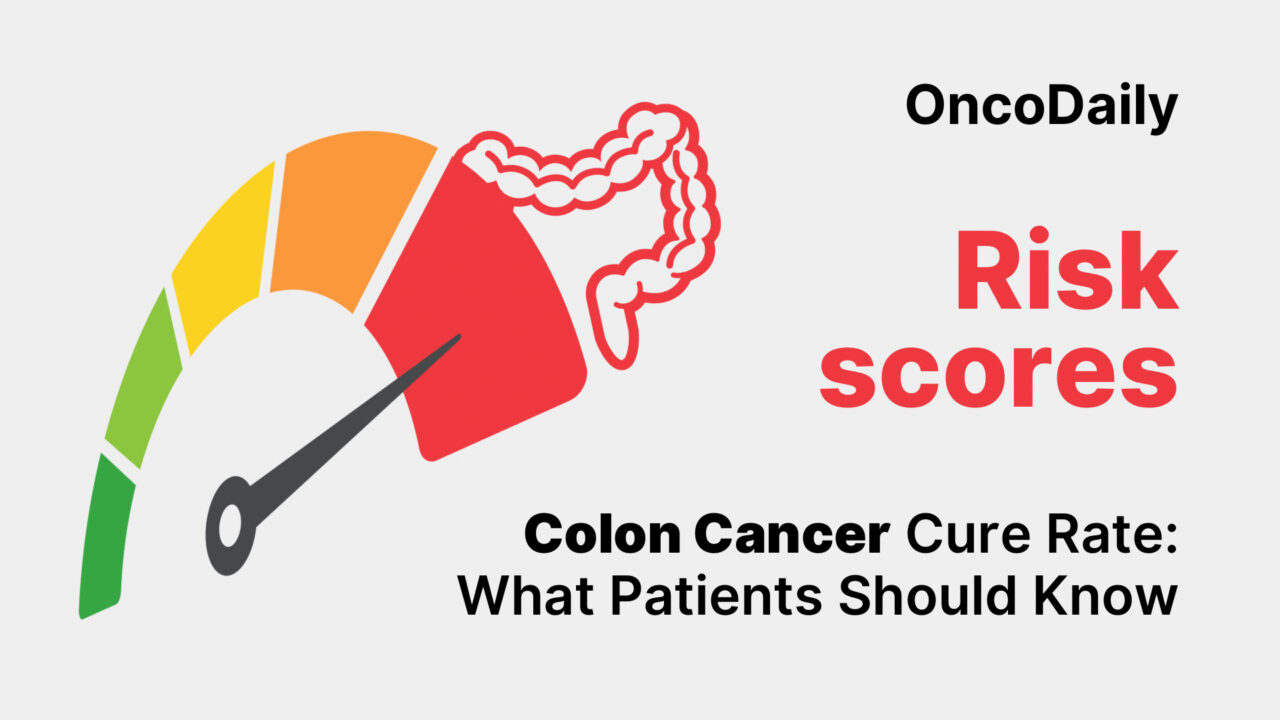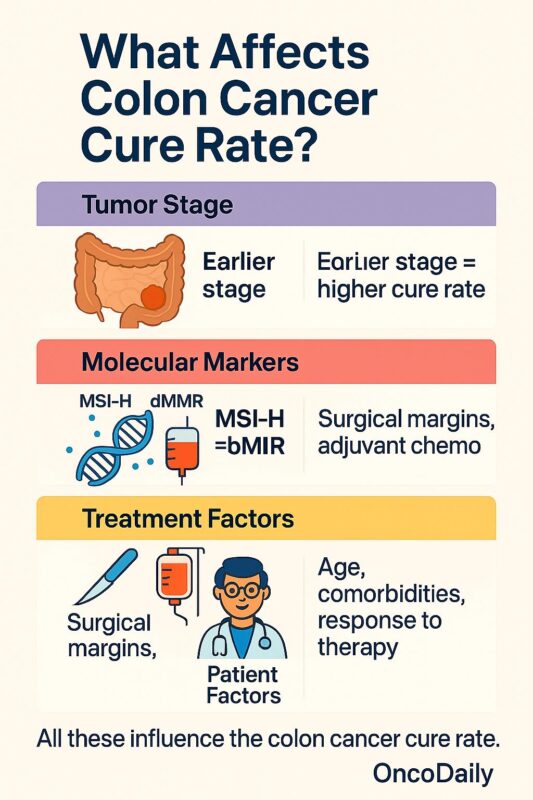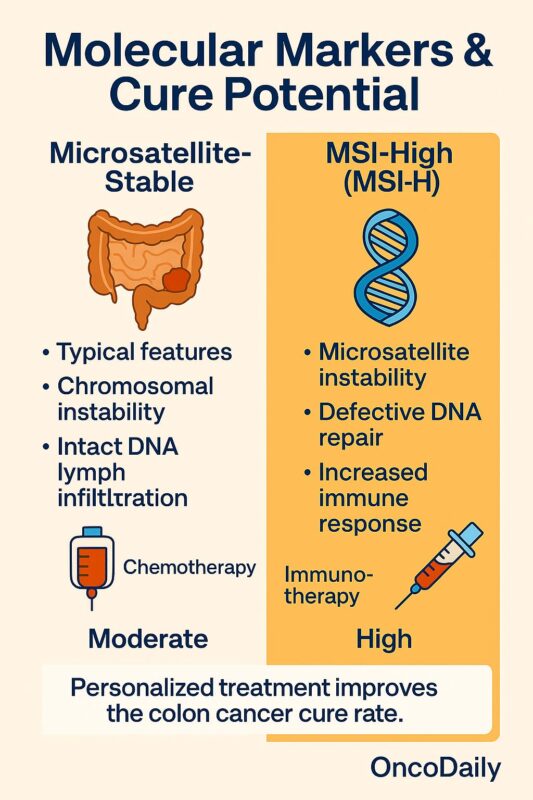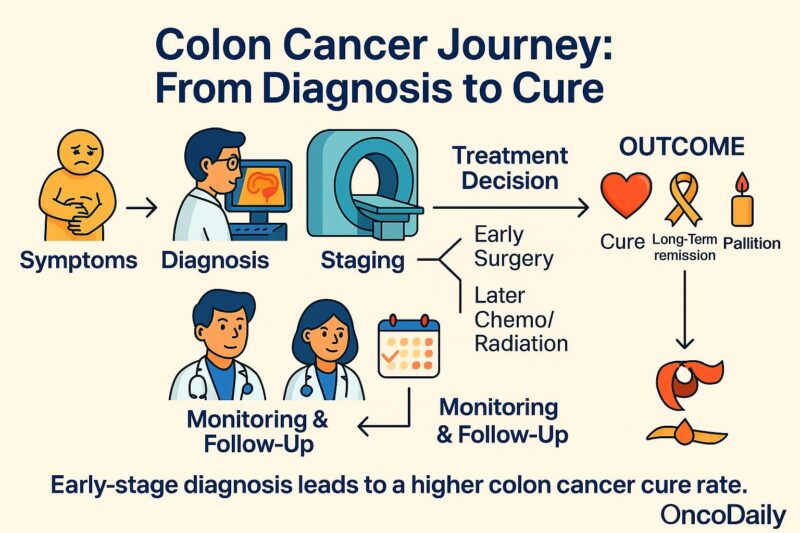
Colon Cancer Cure Rate: What Patients Should Know in 2025
Colon cancer is one of the most common gastrointestinal malignancies, affecting men and women worldwide. It typically begins as a non-cancerous polyp in the inner lining of the colon, which can slowly transform into cancer over several years. Thanks to improved screening and advances in treatment, the colon cancer cure rate has steadily increased, particularly when the disease is detected at an early stage.
This article explores what “cure” means in the context of colon cancer, how curability varies by stage, and which treatments offer the best outcomes.

How Common Is Colon Cancer?
Colon cancer, along with rectal cancer, is grouped under the term colorectal cancer (CRC). Together, they represent the third most commonly diagnosed cancer and the second leading cause of cancer death globally. In the United States, over 106,000 new cases of colon cancer are expected in 2024 alone (American Cancer Society, 2024). While the majority of cases occur in individuals over the age of 50, the incidence of early-onset colon cancer—diagnosed before age 50—is rising, prompting updates in screening guidelines.
What Does “Cure” Mean in Colon Cancer?
In oncology, a “cure” typically means complete eradication of the cancer, such that the patient remains disease-free without recurrence over time. The five-year survival mark is often used as a benchmark for curability, although some patients may experience recurrence after that period.
For colon cancer, cure is usually possible in stage I through stage III disease through surgical removal of the tumor, often followed by chemotherapy in higher stages. Even in stage IV (metastatic) cases, some patients can be cured if the metastases are limited and amenable to surgical removal (Van Cutsem et al., 2020). However, the colon cancer cure rate varies significantly based on how far the disease has spread at the time of diagnosis.
Colon Cancer Cure Rate by Stage
Stage I: At this stage, the cancer is confined to the inner lining or muscular layer of the colon. Surgical removal of the tumor is typically curative, and additional therapy is not required. The five-year survival rate for stage I colon cancer exceeds 90%, indicating a very high likelihood of cure (American Cancer Society, 2024).
Stage II: The tumor has penetrated through the muscle layer into the outer layers of the colon wall but has not yet reached the lymph nodes. Most stage II cancers are treated with surgery alone, though high-risk features—such as T4 tumors, lymphovascular invasion, or poor differentiation—may warrant adjuvant chemotherapy. The expected five-year survival rate is approximately 75–85%, depending on these risk factors (NCCN, 2024).
Stage III: This stage involves regional lymph node metastasis but no distant spread. Cure is still possible with a combination of surgical resection and adjuvant chemotherapy, most commonly using oxaliplatin-based regimens such as FOLFOX (5-fluorouracil, leucovorin, oxaliplatin) or CAPOX (capecitabine and oxaliplatin). The five-year survival rate ranges from 53% to 75%, depending on nodal involvement and tumor grade (Andre et al., 2004). Patients completing full therapy and achieving no evidence of disease within three years have a favorable long-term prognosis.
Stage IV: This refers to distant metastatic disease, most often to the liver, lungs, or peritoneum. While not usually considered curable, a small but important subset of patients can be cured if metastases are resectable and systemic therapy is effective. For example, patients with isolated liver metastases who undergo hepatic resection after chemotherapy can achieve 5-year survival rates of 30–45% (Adam et al., 2012). Newer treatment approaches—such as immunotherapy for MSI-H tumors or targeted therapy for RAS/BRAF mutations—are extending survival in selected cases (Overman et al., 2018).

What Factors Influence the Colon Cancer Cure Rate?
Several key clinical and molecular factors affect the likelihood of cure:
- Stage at diagnosis: The most important determinant of outcome. Early-stage disease is highly curable.
- Lymph node involvement: More affected nodes indicate a higher risk of recurrence.
- Microsatellite instability (MSI): Patients with MSI-high tumors generally have a better prognosis and may respond to immunotherapy.
- KRAS, NRAS, and BRAF mutations: These mutations impact responsiveness to certain targeted therapies.
- Quality of surgical resection: Complete tumor removal with negative margins (R0 resection) is essential.
- Patient age and comorbidities: Influence both treatment tolerability and overall survival.
Which Treatments Offer the Best Chance of Cure?
Surgical resection remains the mainstay of curative treatment. In stage I and II colon cancer, surgery alone may suffice. In stage III, surgery is followed by adjuvant chemotherapy to destroy microscopic residual disease. Oxaliplatin-based regimens such as FOLFOX or CAPOX have been shown to significantly reduce recurrence and improve survival (Andre et al., 2004).
In selected stage IV patients, treatment begins with systemic therapy to shrink tumors and evaluate resectability. Patients whose liver or lung metastases become operable may undergo curative-intent metastasectomy. For MSI-H tumors, immune checkpoint inhibitors such as nivolumab or pembrolizumab may offer long-lasting responses (Overman et al., 2018).

Final Thoughts
Thanks to advances in screening, molecular testing, and combination therapy, the colon cancer cure rate continues to improve. Most patients diagnosed with stage I–III disease can expect to be cured with appropriate therapy. Even some with advanced-stage disease may achieve long-term remission or cure with aggressive multidisciplinary care.
Ongoing follow-up, healthy lifestyle changes, and participation in survivorship care are all vital components of long-term wellness. As research continues, the goal of curing more patients with colon cancer becomes increasingly attainable.
You Can Watch More on OncoDaily Youtube TV
Written by Armen Gevorgyan, MD
-
Challenging the Status Quo in Colorectal Cancer 2024
December 6-8, 2024
-
ESMO 2024 Congress
September 13-17, 2024
-
ASCO Annual Meeting
May 30 - June 4, 2024
-
Yvonne Award 2024
May 31, 2024
-
OncoThon 2024, Online
Feb. 15, 2024
-
Global Summit on War & Cancer 2023, Online
Dec. 14-16, 2023
